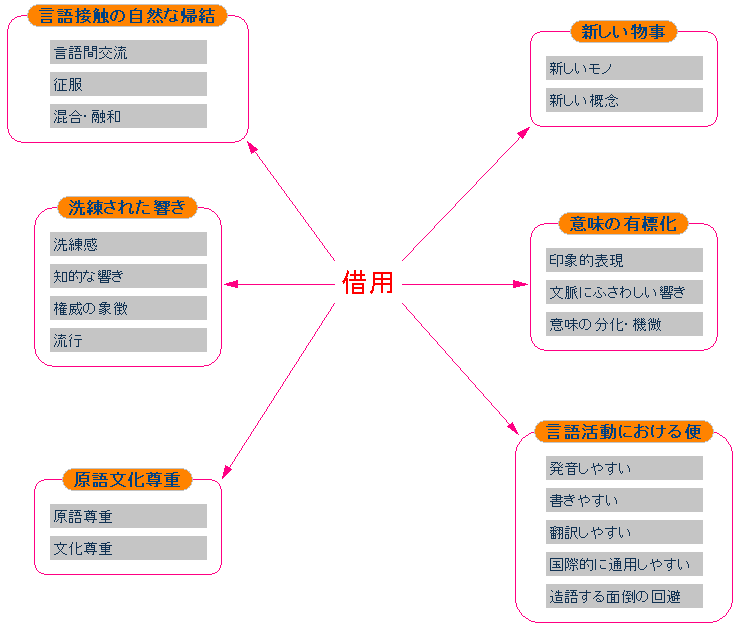「#46. 借用はなぜ起こるか」 ([2009-06-13-1]) の記事で,語彙が他言語から借用される理由を考えた.しかし,この「なぜ」は究極の問いであり,本格的に追究するのであれば,先に他の4W1Hの問いから潰していかなければならない.why の前に,what, who, when, where, how を問う必要があるということだ.そこで borrowing の記事を中心に,本ブログでも様々なアプローチを採ってきた.
借用語の「なぜ」に迫る論考としては,Hans Käsmann (Studien zum kirchlichen Wortschatz des Mittelenglischen 1100--1350. Eng Beitrag zum Problem der Sprachmischung. Tübingen, 1961.) に拠った Görlach (149--50) のものがあるので紹介しよう."causes and situations favouring the transfer" として,次のような分類表を掲げている(語例の前の "A11" などは.Görlach のテキスト参照記号).
(A) Gaps in the indigenous lexis
1. The word is taken over together with the new content and the new object: A11 myrre, D31 senep, F21 sabat, synagoge.
2. A well-known content has no word to designate it: D32 plant
3. Existing expressions are insufficient to render specific nuances ('misericordia', see blow).
(B) Previous weakening of the indigenous lexis
4. The content had been experimentally rendered by a number of unsatisfactory expressions: E15 leorningcniht||disciple.
5. The content had been rendered by a word weakened by homonymy, polysemy, or being part of an obsolescent type of word-formation: C24 hilid||covered; C25 hǣlan = heal, save; H11 hǣlend||sauyoure.
6. An expression which is connotationally loaded needs to be replaced by a neutral expression.
(C) Associative relations
7. A word is borrowed after a word of the same family has been adopted: D49 iust (after justice; cf. judge n., v., judgement).
8. The borrowing is supported by a native word of similar form: læccan × catchen; the process was particularly important with adoptions from Scandinavian.
9. 'Corrections': an earlier loanword is adapted in form/replaced by a new loanword: F2 engel||aungel.
(D) Special extralinguistic conditions
10. Borrowing of words needed for rhymes and metre.
11. Adoptions not motivated by necessity but by fashion and prestige.
12. Words left untranslated because the translator was incompetent, lazy or anxious to stay close to his source: H10 euangelise EV.
There remain a large number of uncertain classifications, most of these somehow connected with 11), a category which is very difficult to define.
(A), (B), (C) はまとめて,既存の語彙体系から生じる借用への圧力ということができるだろうか.「#901. 借用の分類」 ([2011-10-15-1]) でみたタイポロジーとも交差する.(D) はおよそ言語外的な要因というべきものである.通常,語の借用を話題にする場合には,言語外的な要因が注目されることも多いが,この分類は相対的にその扱いが弱いのが特徴だ.結局のところ,最後に但し書きで逃げ口上を打っているように,このような分類を立てることに限界があるのだろう.Fischer (105) は,この分類に不満を表明している.
Like all attempts to "explain" language change, this one suffers from the fact that explanations can only be guessed at and that actual, verifiable proof is hard to come by. Any such typology, therefore, will remain tentative.
冒頭で述べたように,まずは借用の4W1Hを着実に理解してゆくところから始める必要がある.
・ Görlach, Manfred. The Linguistic History of English. Basingstoke: Macmillan, 1997.
・ Fischer, Andreas. "Lexical Borrowing and the History of English: A Typology of Typologies." Language Contact in the History of English. 2nd rev. ed. Ed. Dieter Kastovsky and Arthur Mettingers. Frankfurt am Main: Peter Lang, 2003. 97--115.
[
|
固定リンク
|
印刷用ページ
]
